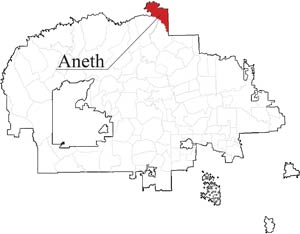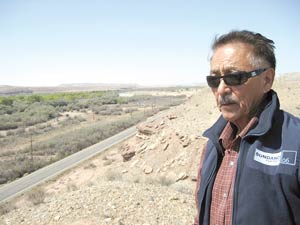Oil and water
Blessed with natural resources, Aneth hasn't fully reaped their benefits
By Cindy Yurth
Tséyi' Bureau
ANETH, Utah, September 27, 2012

 (Times photo — Cindy Yurth)
(Times photo — Cindy Yurth)
The Navajo Generating Station near Page, Ariz. sets the backdrop for a hogan Saturday afternoon. The Navajo Nation and Salt River Project say negotiations for amendments to the current lease for the NGS are ongoing and likely to be completed within the coming months.
(Editor's note: This is the second in a series highlighting each chapter on the Navajo Nation.)
T here are those who say oil and water don't mix, but they have obviously never been to Aneth Chapter.
"We have an oil field, and we have a river," said Robert Billy Whitehorse. "Which other chapter has all that?"
The answer, in case you're wondering: None.
Adds Chapter Vice President Bill Todachennie, "We should all be driving around in luxury cars. But as you can see, we're not."
Like all Navajo chapters, Aneth has to share the wealth with the rest of the tribe — although a clause in 1933 legislation deeded that the "Aneth Extension" to the reservation does reserve 37.5 percent of the oil royalties for the area in which the oil is recovered.
But even that was diluted in 1968 when Congress opted to expand the beneficiaries to include all Utah Navajos.
Still, signs of the oil money are obvious. With a population of 2,236, according to the Chapter's website, Aneth Chapter boasts four schools, a clinic and the two-year-old Diné Professional Plaza, an eye-popping 7,000-square-foot building in Montezuma Creek, Utah that so far houses the Utah Navajo Commission, the Program for Self-Reliance and the local Regional Business Development Office.
The chapter has withdrawn 5.35 acres surrounding the building hoping private developers will step up with plans for office space and a restaurant, but so far nothing has firmed up, said the RBDO's economic development specialist, Veronica Laughter.
"We're just waiting for a developer to come in," Laughter said. "The land is already here, the infrastructure is close by, but so far only one business has submitted an interest."
Nobody has any capital, she explained.
"We've been concentrating on micro-loans of $10,000 or less, and even those are almost impossible for people to collateralize," she sighed.
It can get depressing watching all the oil wells pumping around the chapter and realizing how little wealth is flowing to the residents – until you talk to Robert Whitehorse.
Whitehorse, who served 34 years on the Navajo Nation Council before being hired away by Resolute, the local energy company, as its PR guy, is bullish on Aneth.
"To me," he said, "It's a real exciting place to be."
Stand with Whitehorse atop the mesa where he lives, surrounded by three oil wells and an injection station, and you can almost see his vision of Aneth: A community farm there on the banks of the San Juan; a tourist plaza on the shores of Montezuma Creek with an upscale restaurant and conference center and maybe even a casino; a department store for the locals so they don't have to drive 38 miles to Blanding just for basics.
"We're the gateway to the Four Corners," he boasts, a brochure already forming inside his head. "That way to Cortez and Mesa Verde, that way to Monument Valley, that way to Moab...We just need a place here for people to stay and a few more things for them to do."
There is money floating around Aneth along with oil, Whitehorse says, it's just that it's flowing right out of the chapter. He points to the 120 jobs Resolute provides, and the other 200 people employed by at least 10 Navajo contractors who work with the company.
Yet another 200 souls are on the payroll of the oil-royalty-funded Utah Navajo Health System, many of them high-salaried medical professionals.
"If we could keep all those dollars in the chapter," Whitehorse declares, "we could really do something."
Of course, the chapter could do more if it could keep a bigger share of the oil royalties, and Whitehorse doesn't think that battle was irrevocably lost in 1933.
"I want the other 62-and-a-half percent," he said.
Is the tribe really going to agree to that? Whitehorse thinks they will if they listen to reason.
"Look," he says, "of the 700 or so oil wells in the area, we're only talking about 77 in the Aneth Extension that are covered by the 37-and-one-half-percent rule. Just let them give us 100 percent of those 77 wells, and the people of Aneth will be very happy."
It would take an act of Congress to reverse the 1933 legislation, but Whitehorse is still spry at 74 and hopes to live to see it. He has seen the state of Utah give up trusteeship of the Utah Navajo Trust Fund, which holds the oil money, in 2008 after two decades of litigation by Utah Navajos.
The state's abdication has frozen the trust for four years while Congress listens to the Utah Diné squabble over who should be responsible for it; and a trio of beneficiaries is actually suing the state to force it to resume its trust responsibilities. But Whitehorse thinks turning the trust over to Navajos will be a step in the right direction.
The Navajos of Aneth have been gradually gaining more control of their resources since 1978, when a group of locals took over Texaco's headquarters in their chapter, demanding better environmental controls and more respect for the Natives whose land the corporations were drilling.
"These big companies — Chevron, Texaco, Exxon-Mobil — had been here since the 1960s," Whitehorse explained. "When they first came, all they knew about Indians was from John Wayne movies. I don't think they even thought of us as human beings. They said, 'It's OK if we run over their sheep. It's not our fault.'"
In 1978, the Anethites presented the oil companies with a list of 21 demands, which the firms agreed to meet. But things got rocky again in 1987, when the locals accused the companies of discriminating against Diné workers, among other things. Another 10 demands were added, and the companies agreed.
Among the old-timers, said Whitehorse, the 31 demands are known as the "Aneth Bible."
Through a vigorous but mostly peaceful protest, the Anethites had improved their working conditions, their environment, and gained respect. It's a matter of pride in the chapter to this day, and Resolute — which bought out the large companies' interest in 2004 — knows the history.
"That's one reason they hired me, to be a liaison with the chapter people," Whitehorse explained. "I know what they're thinking, and when the company needs to communicate something to them, they call me."
But oil may not be the chapter's most valuable natural resource.
Faced with the prospect of reading every book in the tiny San Juan County branch library, 14-year-old Lyndon Sandoval and a friend are posting signs for a car wash to beef up the library's book budget.
Sandoval admits there's not much for kids his age to do in Aneth, other than "chores and walking up the mesas," but he wouldn't trade it.
"It's a good place to be," he said. "The weather's nice."
Sandoval may be fishing for good things to say about his chapter, but as you watch the tall, stately teen and his friend stroll down the dirt road with a stack of car wash posters and a roll of duct tape, you realize the charm of this little, picturesque chapter is not the weather, or the river, and certainly not all the oil well pumps dotting the landscape like giant grasshoppers.
It's the people who invest in it and call it home.

